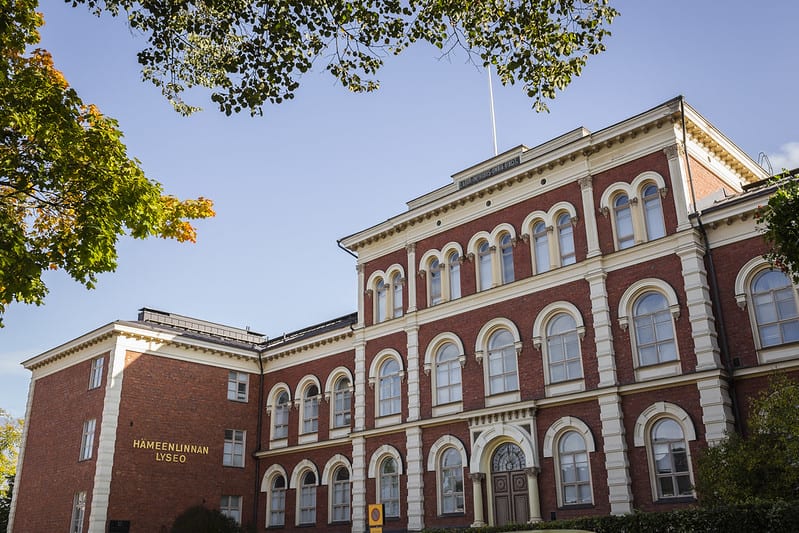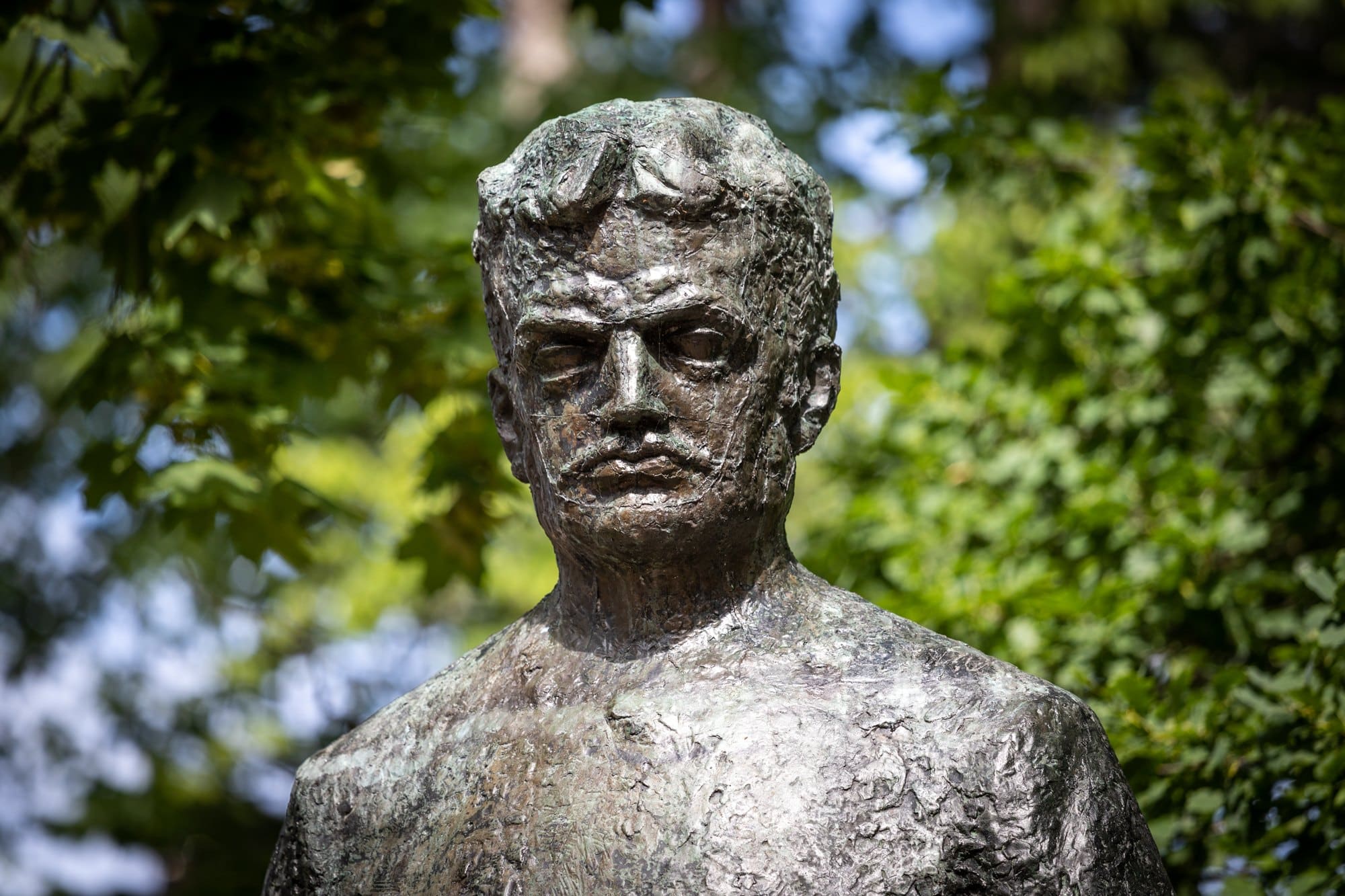Finland’s most famous composer, Jean Sibelius, was born in Hämeenlinna 1865. The memory of the composer is still honoured in Hämeenlinna today. You can visit the Birthplace of Sibelius in the centre of Hämeenlinna, which serves as a museum and hosts concerts. In the Sibeliuksenpuisto Park, you can sit on the benches and listen to the compositions of the wood series. In the middle of the park, sculptor Cain Tapper’s “Young Sibelius” statue observes visitors. On the edge of the park stands the magnificent Lyceum of Hämeenlinna, Sibelius’s former school. In the Aulanko area you can find the Sibelius Forest, a nature reserve whose paths Sibelius used to hike and get inspiration for his compositions.
Sibelius spent his childhood and school years in Hämeenlinna
In the time Sibelius was born the country was searching for its own national identity as a part of the Russian empire. His father Christian Gustaf Sibelius worked as the municipal doctor in Hämeenlinna. He had a doctoral degree in medicine but was a bohemian at heart. Christian Sibelius died in 1868 and left behind a pile of unpaid bills. The mother of the family, Maria, moved back to her mother’s home with the children.
Thanks to the Fennoman movement, a national movement that emphasised the Finnish language and culture, a Finnish-language lyceum was opened in Hämeenlinna in 1876, and Sibelius was among the students of that school. He grew up to be bilingual and already early in his life he familiarised himself with the works of J. L. Runeberg, Z. Topelius and Aleksis Kivi as well as the Finnish national epic Kalevala. For Sibelius, Hämeenlinna was, above all, his school town.
Even as a child, Sibelius demonstrated his talent in music, although his family was not particularly musical. However, both his parents used to sing and play some instrument, and several important names in the history of Finnish music can be found in his family, among them A. G. Ingelius, who composed the first Finnish symphony, and Aino Ackté. Sibelius began his piano lessons at the age of seven, taugh by his aunt Julia. His first known composition dates back to around 1881 when, on a piece of paper, he wrote down Vesipisaroita viululle ja sellolle (”Water drops for violin and cello”).
Jean Sibelius was already 16 years old when he began his violin lessons, but the violin inspired him more than any other instrument. During his years in Hämeenlinna, 1880-1885, he had time to write about 15 compositions, piano music and chamber music for two to four players. In addition, before he moved to Helsinki, he finished a string quartet in E flat major.

To world to study via Helsinki
In 1885, Jean Sibelius started studying law at Aleksander’s Imperial University in Helsinki and also enrolled in the Helsinki music school (now the Sibelius Academy). Music, however, was the love of his life and he abandoned his university studies. He concentrated especially on learning to play a violin, but had to admit that he had been too old when he started learning. This was when composing took the first place in his life. While he lived in Helsinki, Sibelius wrote over a hundred pieces of music, and already when he was studying he was considered a musical genius.
In addition to concentrating on his studies, during his years in Helsinki Sibelius made many friends, among them the writer Juhani Aho and the numerous children of the family Järnefelt, including his future wife Aino. Among his friends was also the internationally known pianist and composer Ferruccio Busoni who taught in the music school.
Sibelius continued his studies in Berlin where he also attended various concerts. He especially liked to hear the works of Beethoven, Richard Wagner and Richard Strauss. After Berlin, Sibelius studied in Vienna. Until then, he had mainly written chamber music, but in Vienna he also started to compose orchestral music. In addition, he became increasingly interested in the Finnish language and all things Finnish. He took great interest in, among other things, Kalevala.
Setting up a family and success both home and abroad
In Vienna, he started to compose a tone poem Kullervo. In 1891 he returned to Finland and went to Porvoo to meet Larin Paraske whose authentic rune-singing and keening (improvised vocal lament) had their influence onKullervo. The premiere of the tone poem in 1892 was a success. In the same year, Sibelius married Aino Järnefelt and, inspired by Karelianism, the newlyweds headed to Ilomantsi and Korpiselkä, the birth-places of Kalevala. Over the years, Sibelius and his wife had six daughters. To be able to support his family, Sibelius had to teach the violin and music theory in the music school and orchestral school until the turn of the century.
During the period of oppressive russification, Sibelius and his music became obvious symbols of the strengthening national movement. In 1899 he composed a programme piece Suomi herää (”Finland awakes”) that was later renamed Finlandia. At the turn of the century, however, Sibelius distanced himself from national romanticism when he and his family lived in Italy. His style became more classical. The change of style was further influenced by Sibelius’ move into his home Ainola in 1904. At the beginning of the 20th century, his music became lighter, he received recognition abroad and gained a permanent foothold in England where he visited in 1905. Soon after this his work became darker again, one reason for which might have been throat cancer that was operated in 1908.
The greatest composer of his time
By 1910, Jean Sibelius had established his international reputation, and concert tours took him to Göteborg, Riga, Copenhagen and Berlin. He received various offers for important posts, such as a professorship in composition in Vienna and a teachership at a music school in the United States. In 1914 he was awarded an honorary doctorate at Yale University. The time of the First World War was economically difficult for Sibelius, and he was forced to compose minor pieces such as songs and piano compositions, many of which are, however, excellent.
In the 1920s, Sibelius had his late symphonic period. In 1923 he completed his Sixth Symphony and in 1924 he finished his Seventh Symphony. These and Tapiola, a tone poem written in 1926, are considered the most mature works by Sibelius. He gradually became increasingly critical about his own work and in the late 1940s he burned some of his compositions. During the last years of his life, he was acknowledged as the greatest composer of his time.
Reference: An article by Veijo Murtomäki at www.kansallisbiografia.fi
